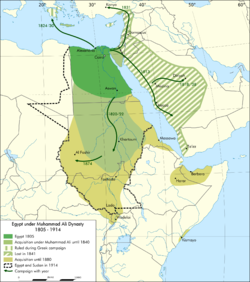



The governors of pre-independence Sudan were the colonial administrators responsible for the territory of Turco-Egyptian Sudan and Anglo-Egyptian Sudan, an area equivalent to modern-day Sudan and South Sudan.




The governors of pre-independence Sudan were the colonial administrators responsible for the territory of Turco-Egyptian Sudan and Anglo-Egyptian Sudan, an area equivalent to modern-day Sudan and South Sudan.
(Dates in italics indicate de facto continuation of office)
| Tenure | Portrait | Incumbent | Notes |
|---|---|---|---|
| Turco-Egyptian Sudan | |||
| November 1820 to 1821 | Isma'il Kamil Pasha , Commander | ||
| April 1821 to September 1824 | Muhammad Bey Defterdar , Commander | ||
| September 1824 to May 1825 | Osman Bey Jarkas , Commander | ||
| May 1825 to March 1826 | Mahu Bey Urfali , Commander | ||
| March 1826 to 1835 | Ali Khurshid Agha , Governor | ||
| 1835 to June 1838 | Ali Khurshid Pasha , Hakimdar | Governor-General | |
| June 1838 to 6 October 1843 | Ahmad Pasha abu Widan , Hakimdar | Governor-General | |
| 1843 to 1845 | Ahmad Pasha Manikli (Manliki), Hakimdar | Governor-General | |
| 1845 to 1850 | Khalid Khusraw Pasha , Hakimdar | Governor-General | |
| 1850 to January 1851 | 'Abd al-Latif Pasha , Hakimdar | Governor-General | |
| January 1851 to May 1852 | Rustum Pasha Jarkas , Hakimdar | Governor-General | |
| May 1852 to 1853 | Isma'il Haqqi Pasha abu Jabal , Hakimdar | Governor-General | |
| 1853 to 1854 | Salim Pasha Sa'ib al-Jaza'irli , Hakimdar | Governor-General | |
| July 1854 to November 1854 | Ali Pasha Sirri al-Arna'ut , Hakimdar | Governor-General | |
| 1854 to 1855 | Ali Pasha Jarkas , Governor | ||
| 1856 to 1858 | Arakil Bey al-Armani , Governor | ||
| 1859 to 1861 | Hasan Bey Salama Jarkas , Governor | ||
| 1861 to 1862 | Muhammad Rasikh Bey , Governor | ||
| 1862 to 1865 | Mūsā Pasha Ḥamdī , Hakimdar | Governor-General | |
| 1865 to November 1865 | 'Umar Bey Fakhri , acting Hakimdar | acting Governor-General | |
| November 1865 to 1866 | Ja'afar Pasha Sadiq , Hakimdar | Governor-General | |
| 1866 to 5 February 1871 | Ja'afar Pasha Mazhar , Hakimdar | Governor-General | |
| 5 February 1871 to October 1872 | Ahmad Mumtaz Pasha , Hakimdar | Governor-General | |
| October 1872 to 1872 | Edhem Pasha al-Arifi at-Atqalawi , acting Hakimdar | acting Governor-General | |
| 1873 to 1876 |  | Isma'il Ayyub Pasha , Hakimdar | Governor-General |
| May 1877 to December 1879 |  | Charles George Gordon ("Gordon Pasha"), Hakimdar | Governor-General, 1st time |
| December 1879 to February 1882 |  | Muhammad Rauf Pasha , Hakimdar | Governor-General |
| 4 March 1882 to 11 May 1882 |  | Carl Christian Giegler ("Giegler Pasha"), acting Hakimdar | acting Governor-General |
| May 1882 to March 1883 | 'Abd al-Qadir Pasha Hilmi , Hakimdar | Governor-General | |
| March 1883 to 5 November 1883 | 'Ala al-Din Pasha Siddiq , Hakimdar | Governor-General | |
| February 1884 to 18 February 1884 | Henry Watts Russell de Coetlogon , acting Hakimdar | acting Governor-General | |
| 18 February 1884 to 26 January 1885 |  | Charles George Gordon ("Gordon Pasha"), Hakimdar | Governor-General, 2nd time; Killed at the end of the Siege of Khartoum |
| 26 January 1885 to 2 October 1898 | Territory of Turkish Sudan under complete control of Mahdiyah (Mahdist State) | ||
| Mahdist State | |||
| 29 June 1881 to 22 June 1885 |  | Muhammad Ahmad , Mahdi | Self-proclaimed Mahdi, Islamic Messiah |
| 22 June 1885 to 2 September 1898 |  | Abdallahi ibn Muhammad , Khalifa | Self-proclaimed Caliph, successor to Muhammad Ahmad; Defeated in the Battle of Omdurman, and later killed in the Battle of Umm Diwaykarat |
| British Military Administration | |||
| 2 September 1898 to 19 January 1899 |  | The 1st Baron Kitchener of Khartoum , Military Governor | Simultaneously served as Sirdar. Was known as Sir Herbert Kitchener up until 31 October 1898 |
| Anglo-Egyptian Sudan (condominium) | |||
| 19 January 1899 to 22 December 1899 |  | The 1st Baron Kitchener of Khartoum , Governor-General | Simultaneously served as Sirdar. Was later created The 1st Earl Kitchener, in July 1914 |
| 22 December 1899 to 31 December 1916 |  | Sir Reginald Wingate , Governor-General | Simultaneously served as Sirdar |
| 1 January 1917 to 20 November 1924 |  | Sir Lee Oliver Fitzmaurice Stack , Governor-General | Simultaneously served as Sirdar; assassinated in Cairo [1] |
| 21 November 1924 to 5 January 1925 | Wasey Sterry , acting Governor-General | ||
| 5 January 1925 to 6 July 1926 |  | Sir Geoffrey Francis Archer , Governor-General | The first civilian Governor-General [2] |
| 31 October 1926 to 10 January 1934 |  | Sir John Loader Maffey , Governor-General | |
| 10 January 1934 to 19 October 1940 |  | Sir George Stewart Symes , Governor-General | |
| 19 October 1940 to 8 April 1947 | Sir Hubert Jervoise Huddleston , Governor-General | ||
| 8 April 1947 to 29 March 1954 |  | Sir Robert George Howe , Governor-General | |
| 29 March 1954 to 12 December 1955 |  | Sir Alexander Knox Helm , Governor-General | |
| 12 December 1955 to 1 January 1956 |  | Muhammad Ahmad Abu Rannat , acting Governor-General | Chief Justice of Sudan |
| 1 January 1956 | Independence as the Republic of Sudan | ||
For continuation after independence, see: List of heads of state of Sudan
